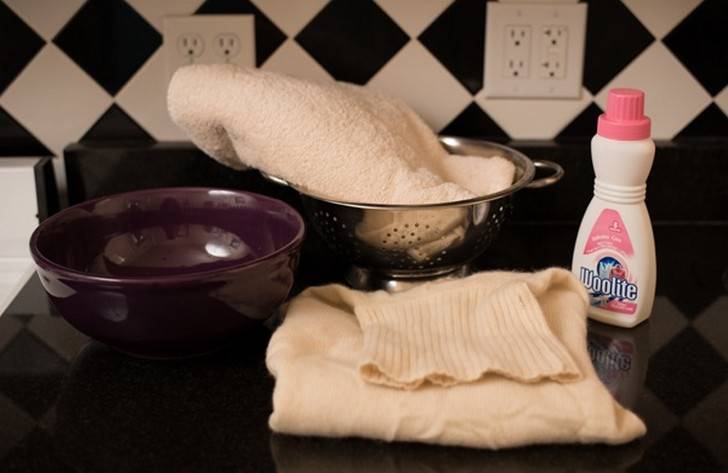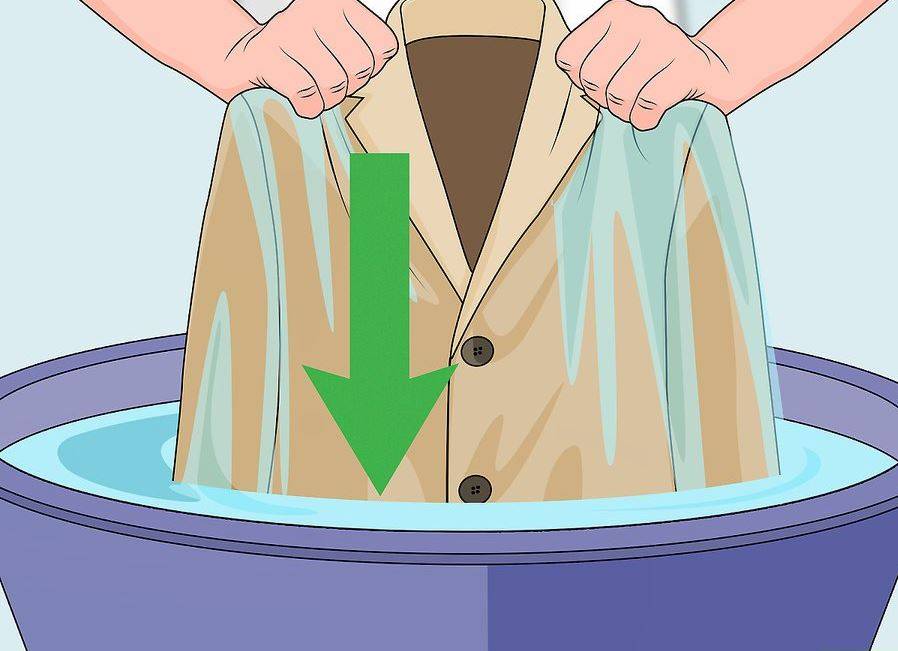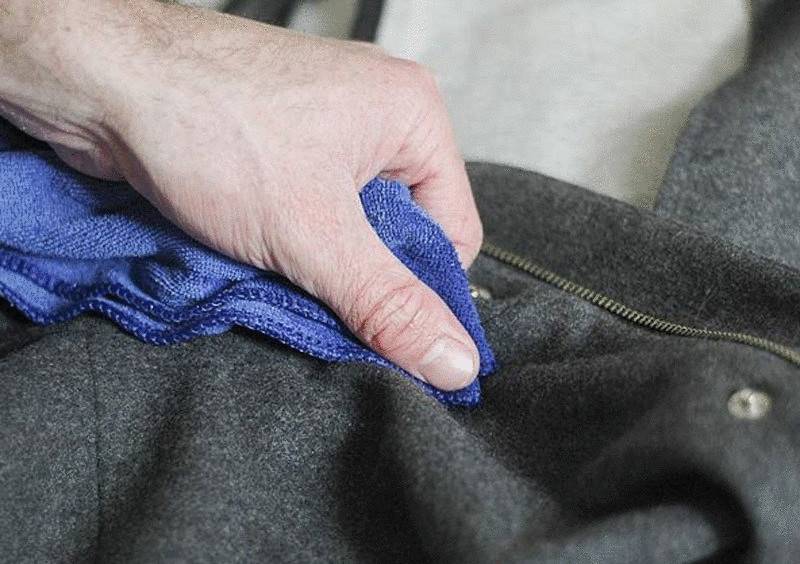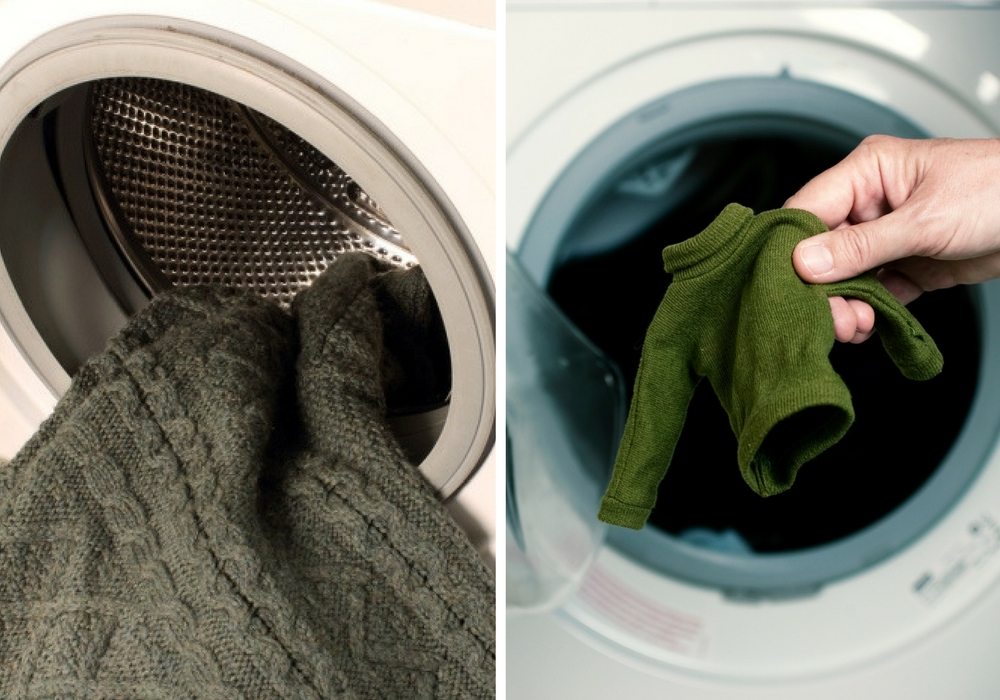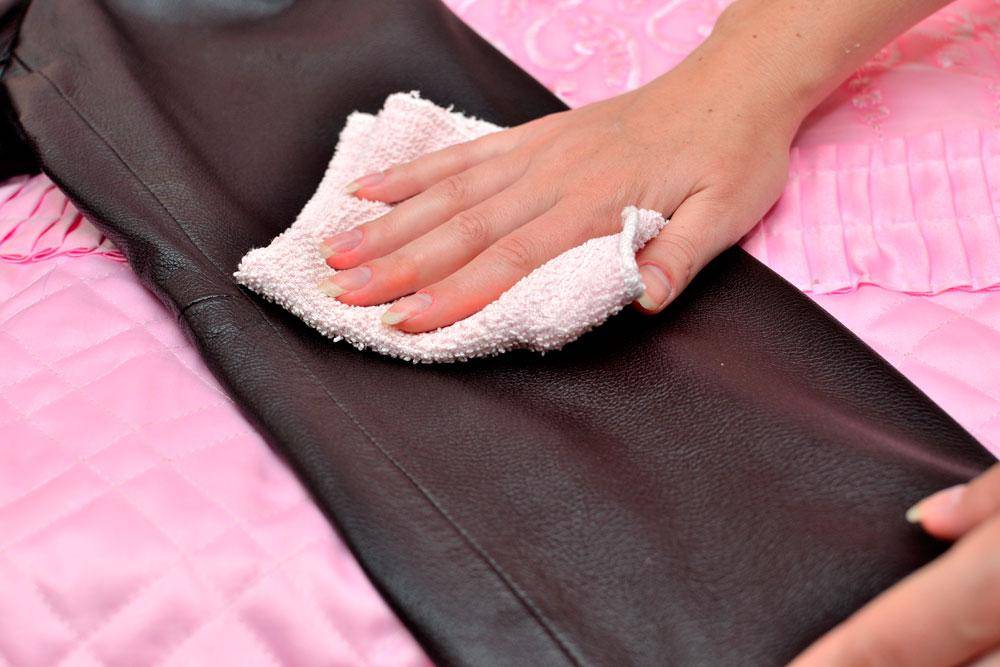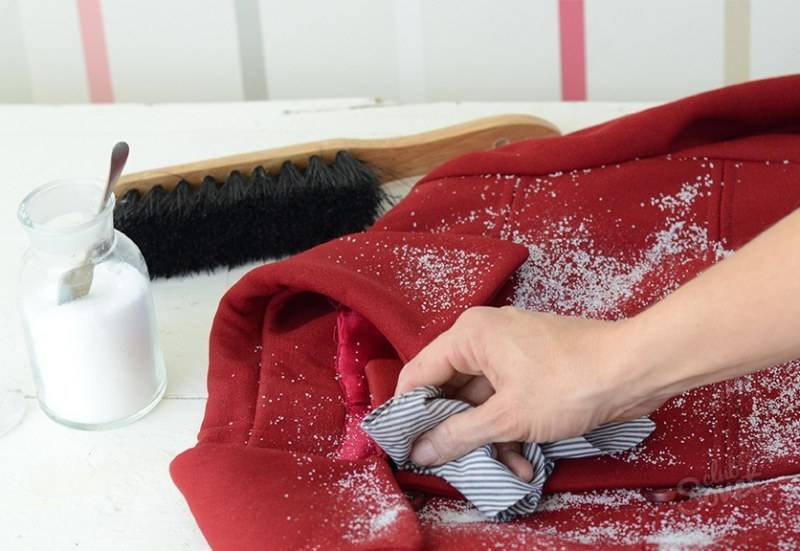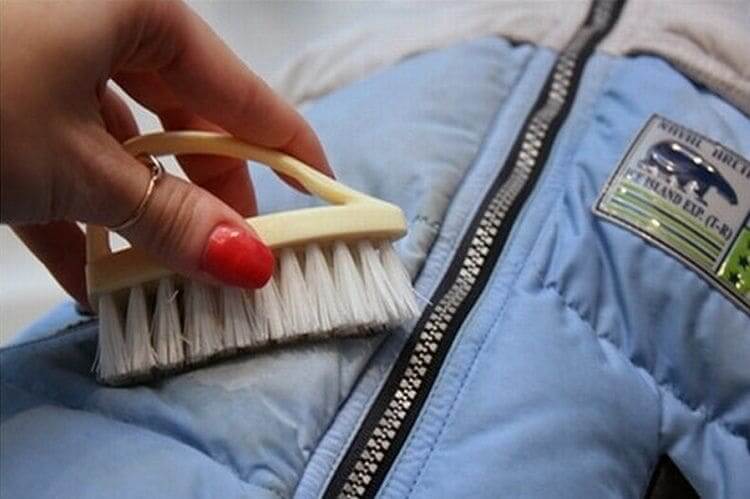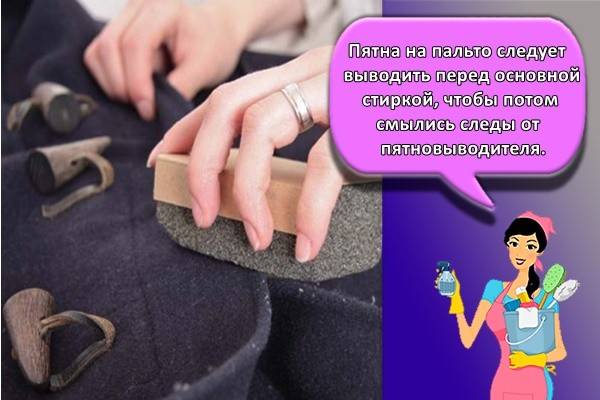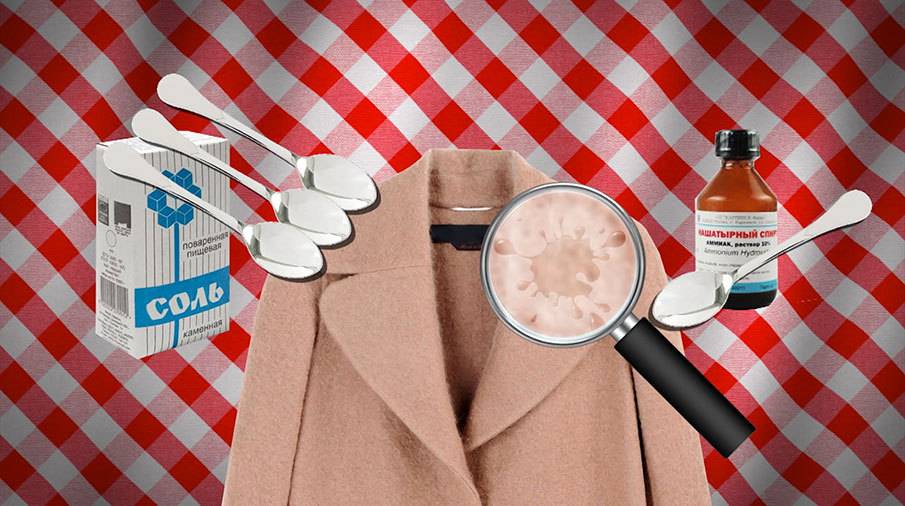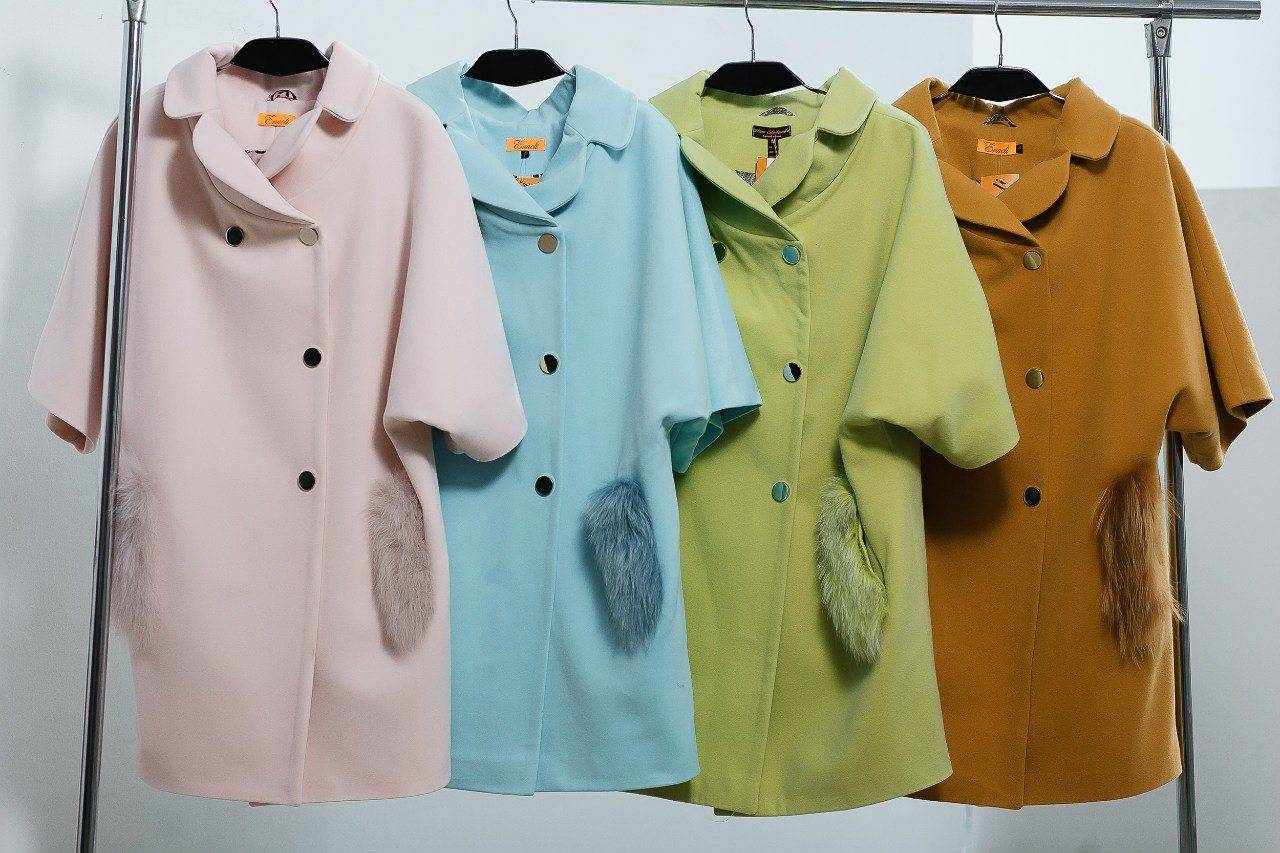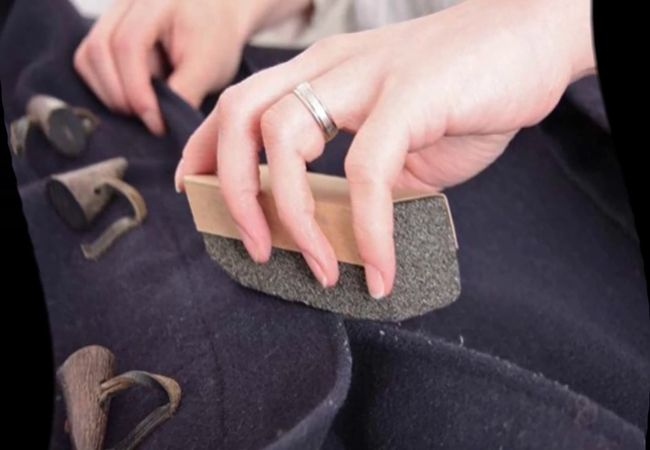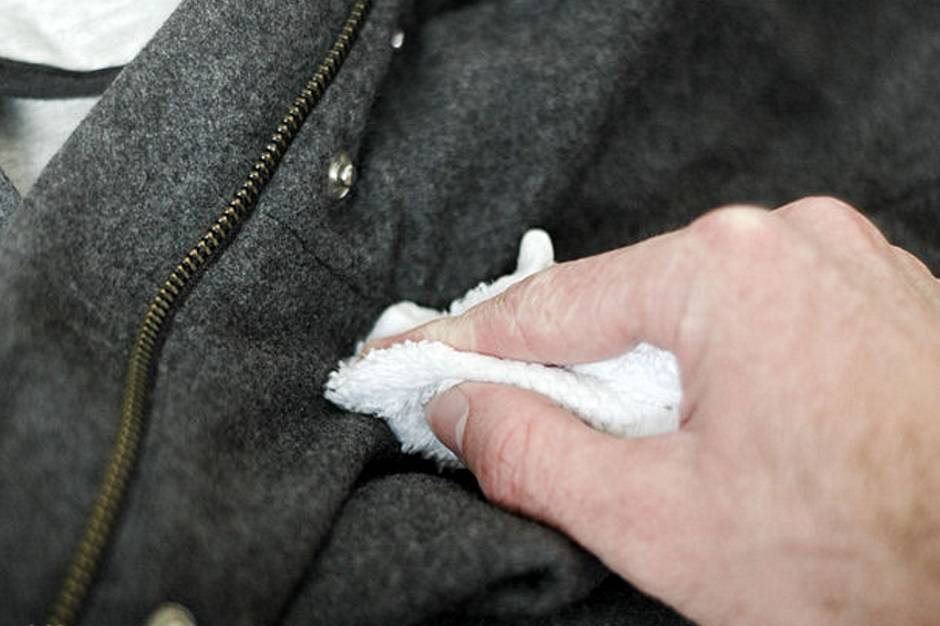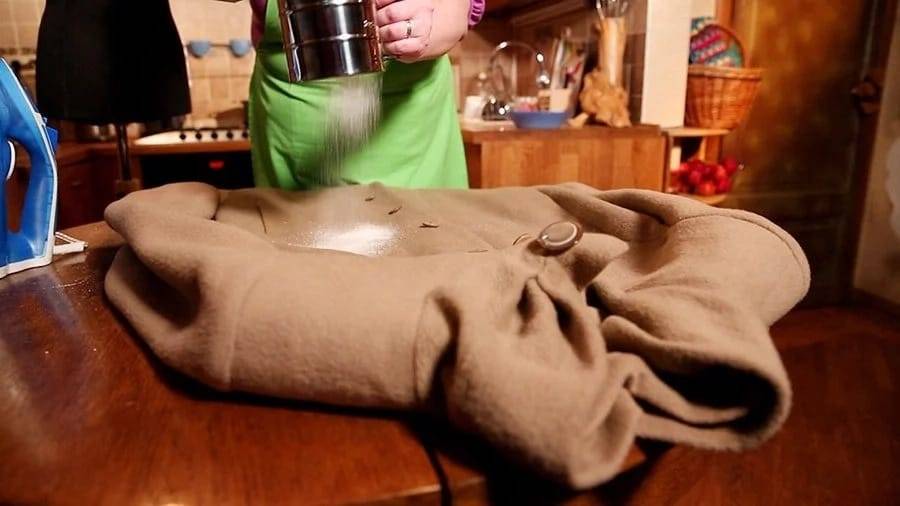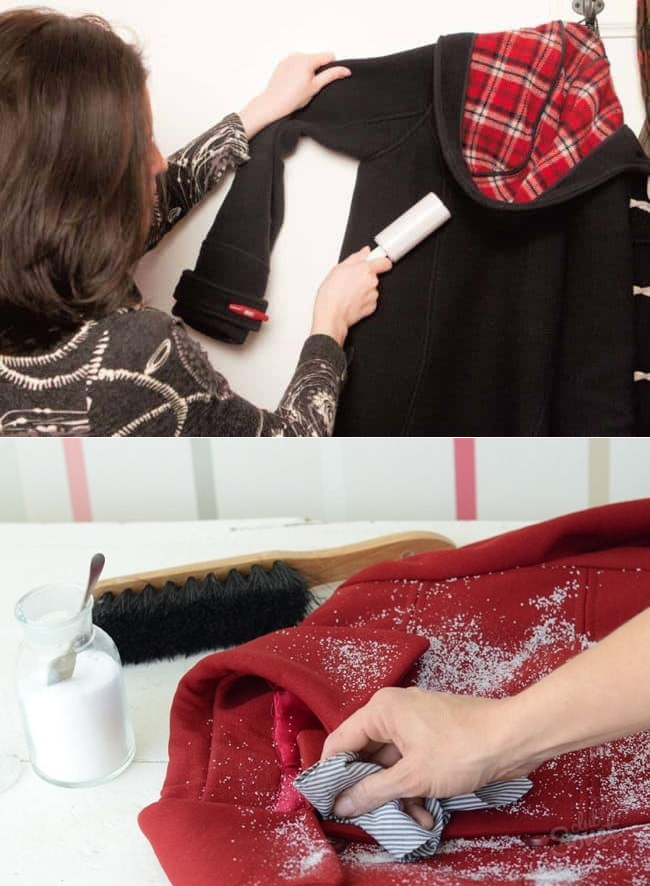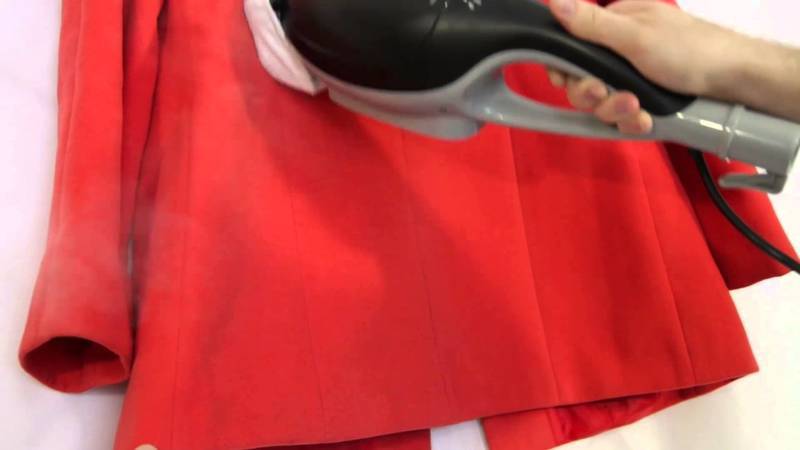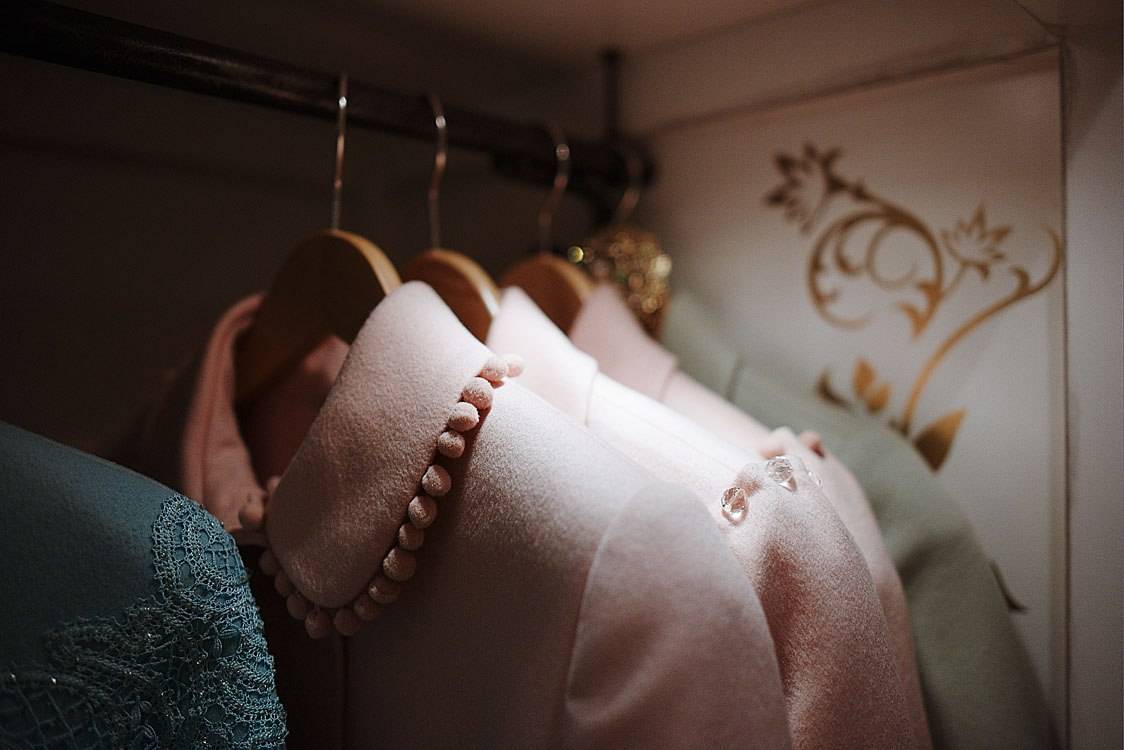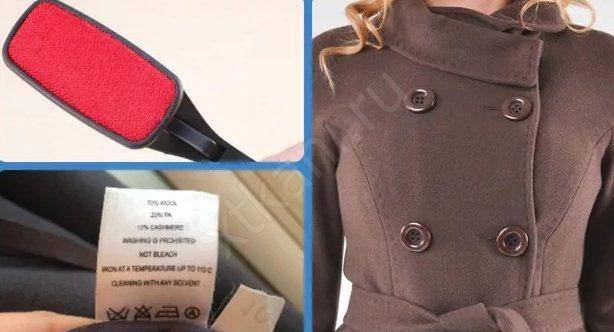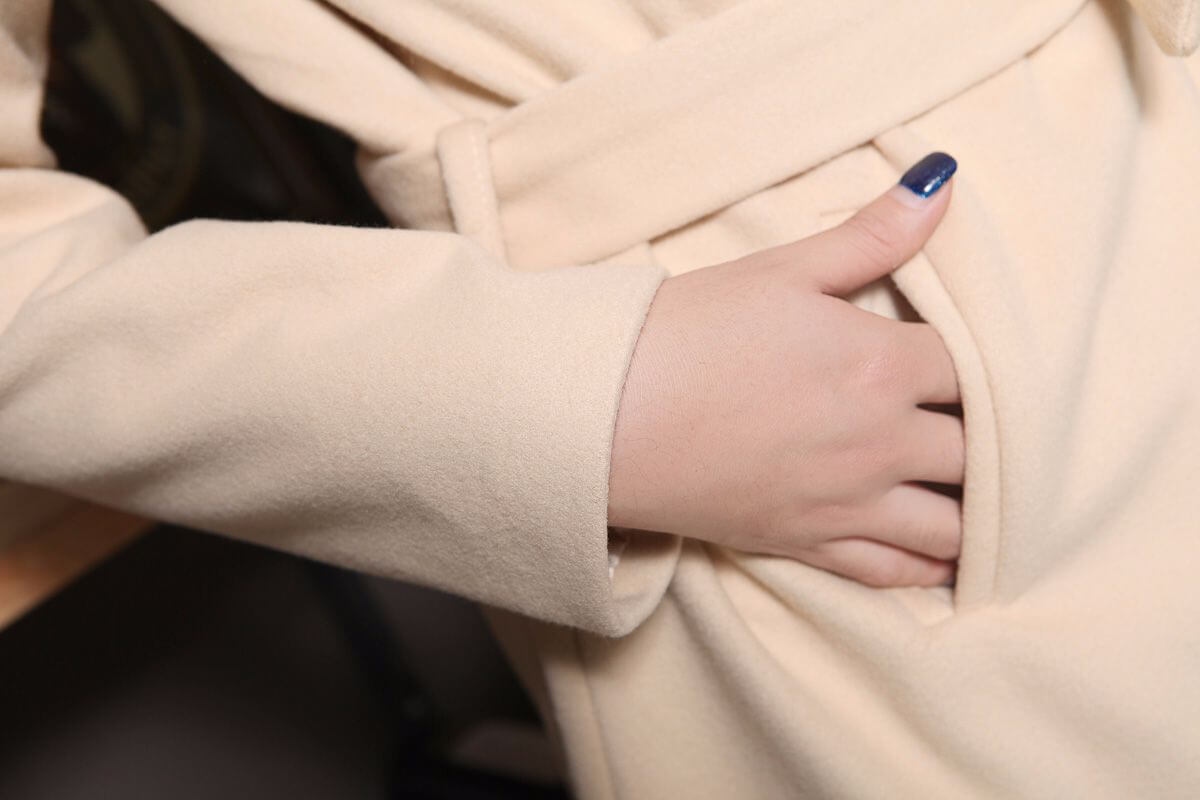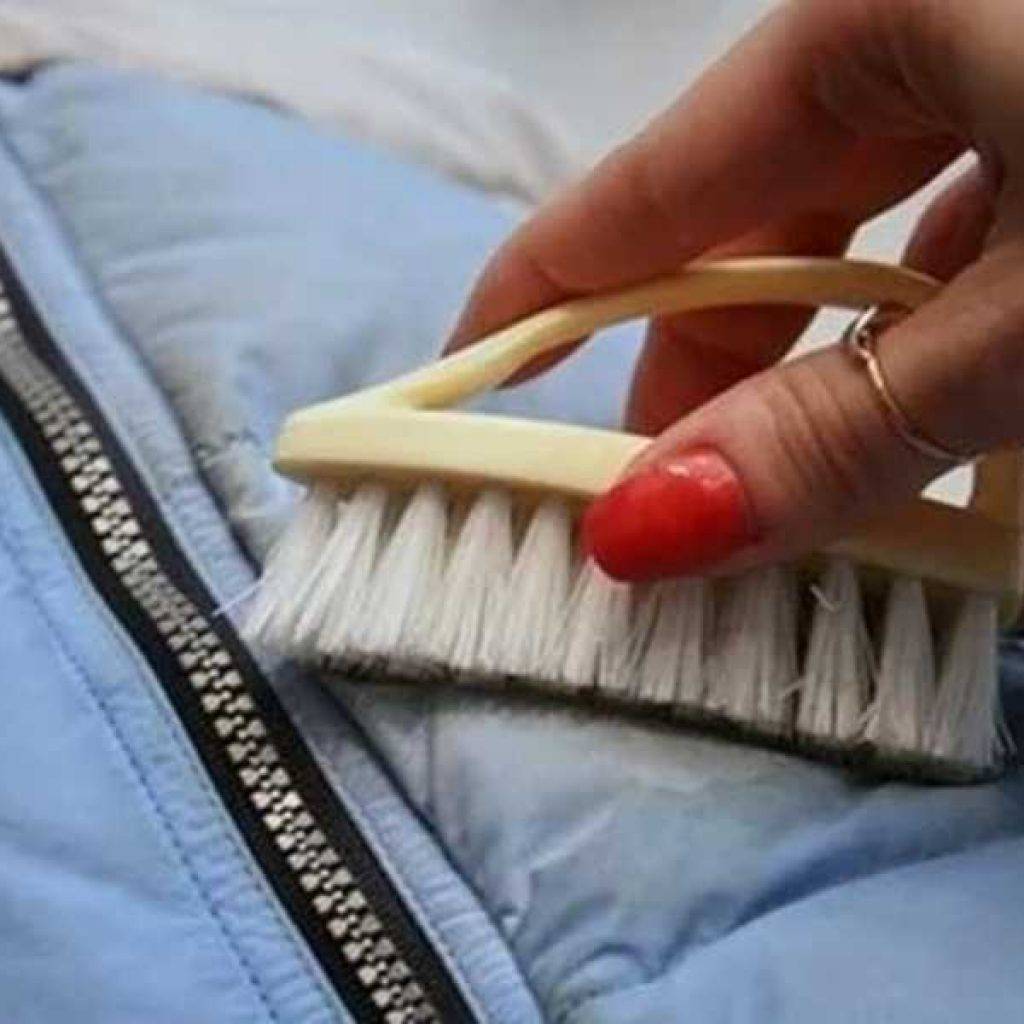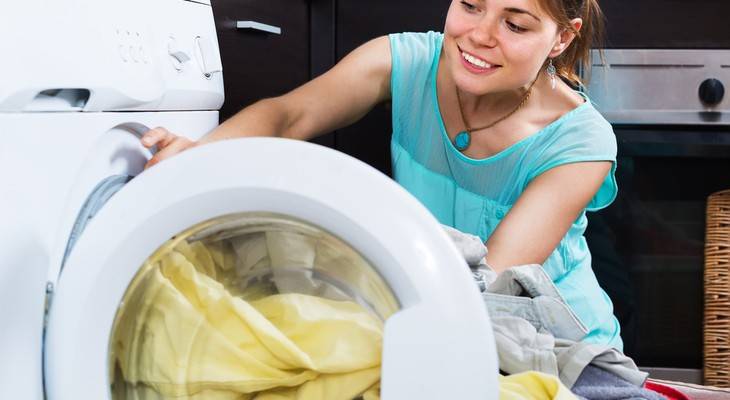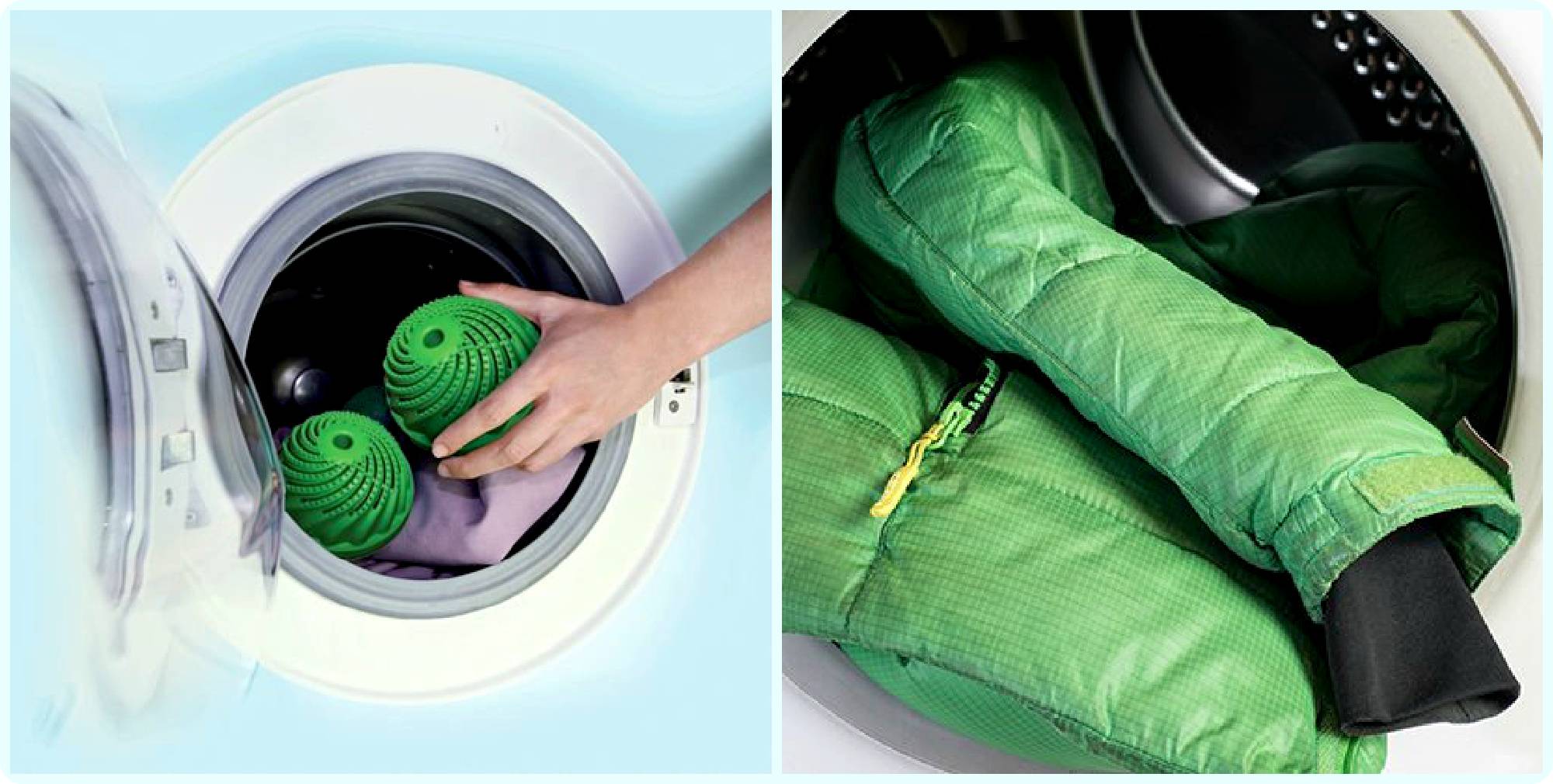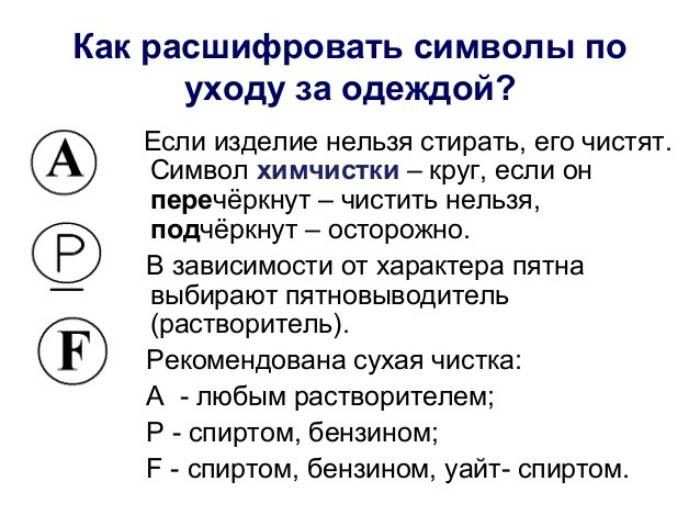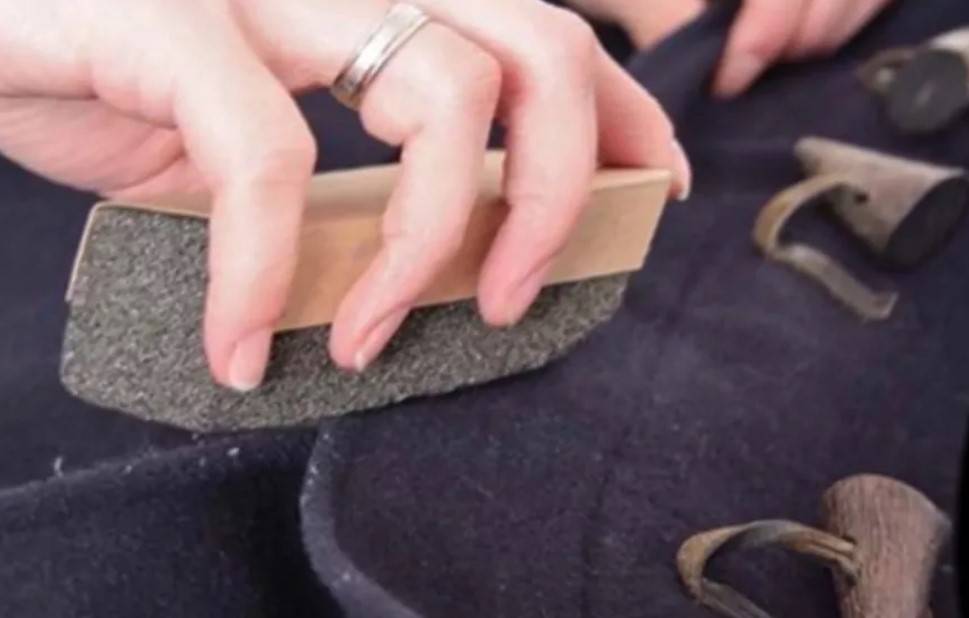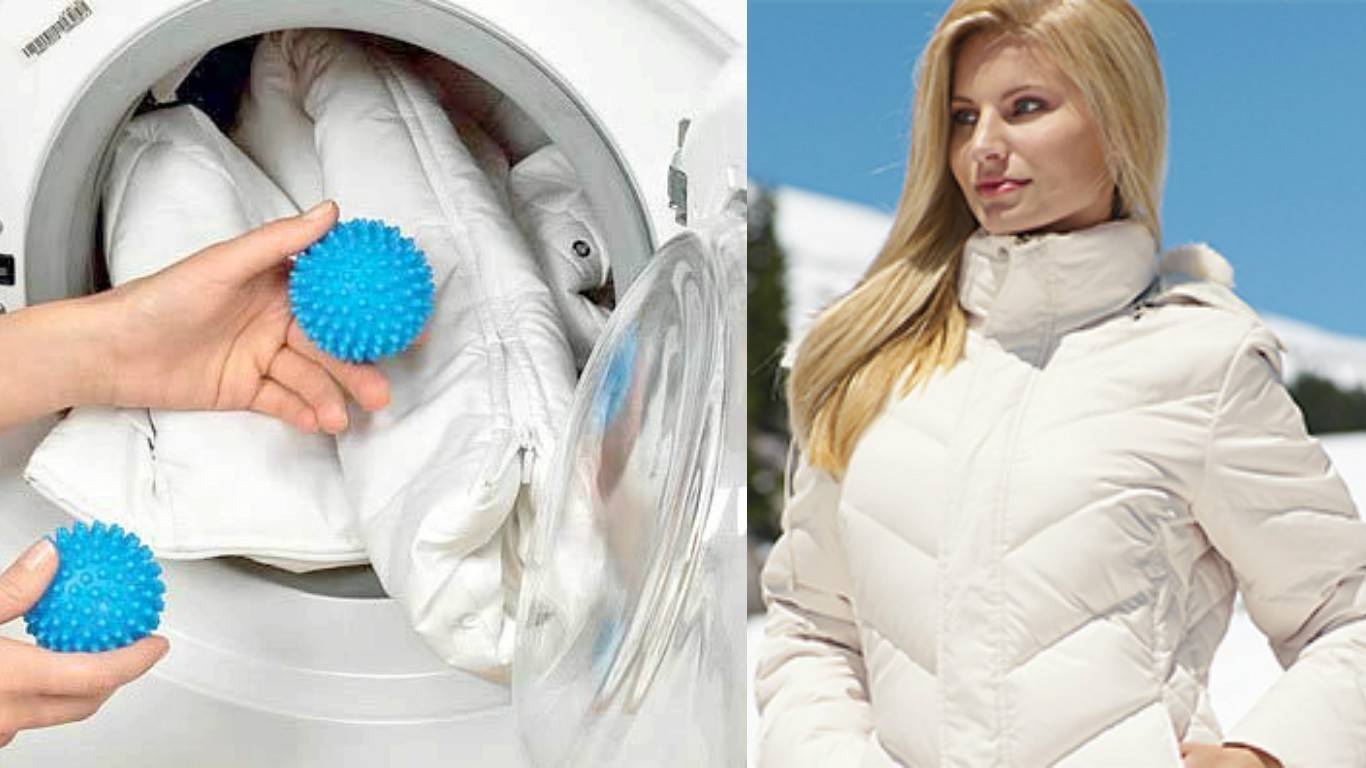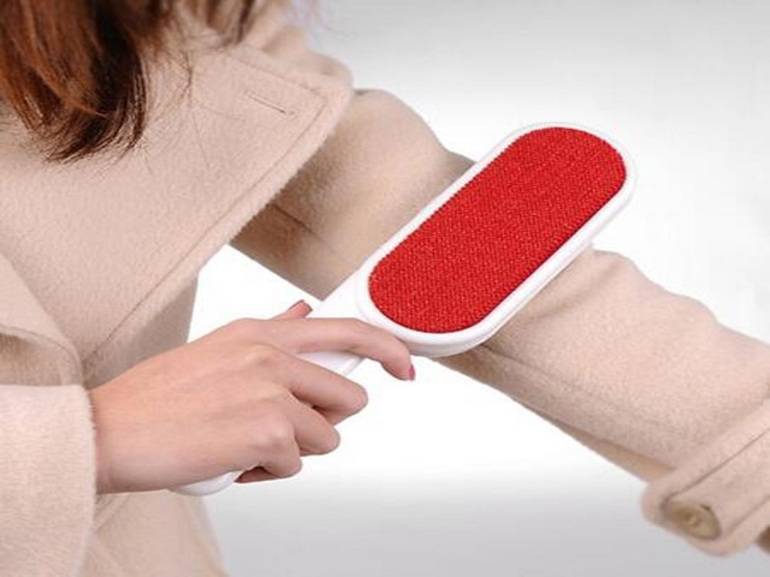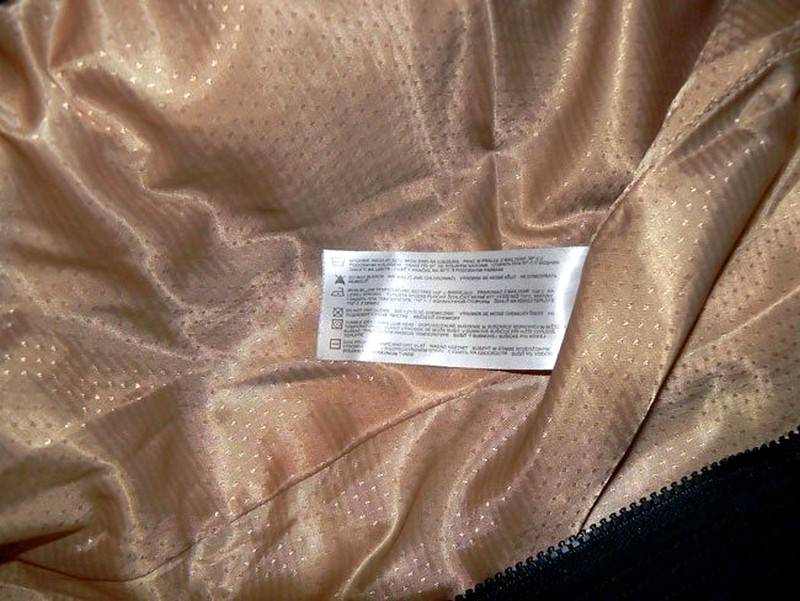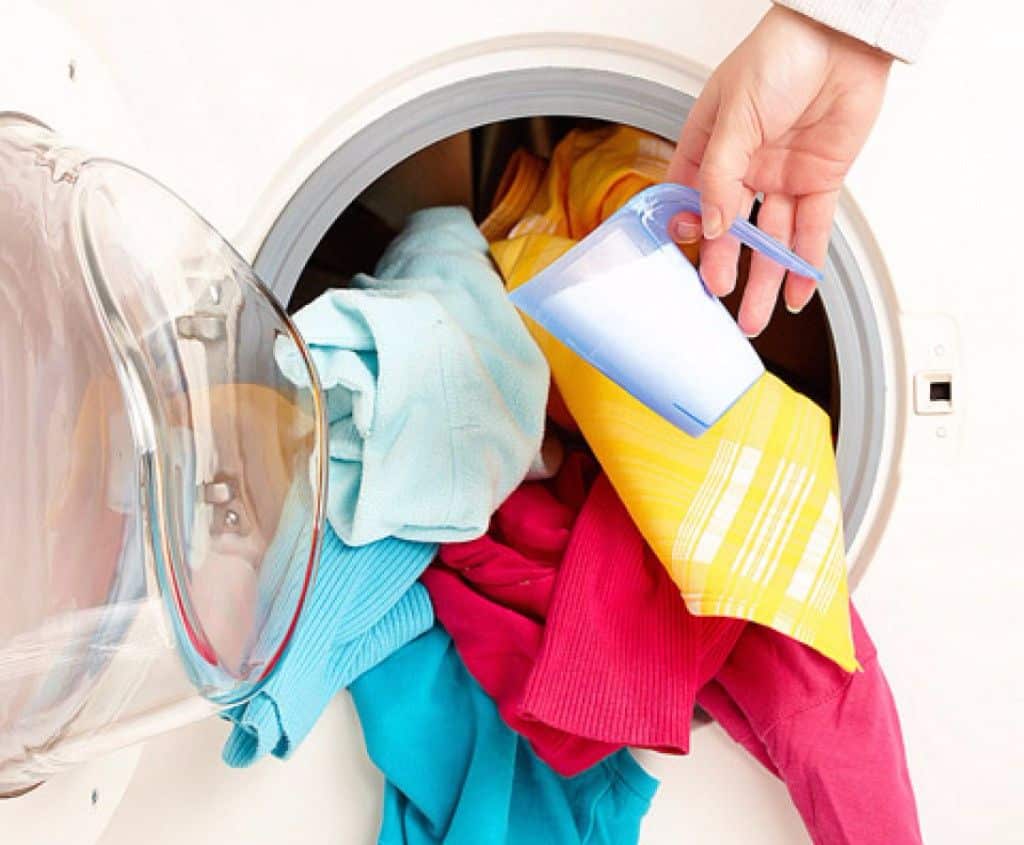How to clean a wool coat at home
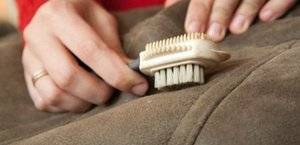 Woolen products have always been highly valued because they are natural. However, they often lose their color, so you need to monitor them very carefully. Before cleaning the coat on the wrong side, a test should be carried out to determine how the material interacts with a particular substance.
Woolen products have always been highly valued because they are natural. However, they often lose their color, so you need to monitor them very carefully. Before cleaning the coat on the wrong side, a test should be carried out to determine how the material interacts with a particular substance.
Basically, the following tools are used to clean a woolen coat at home:
- soap solution with ammonia;
- a mixture of alcohol and vinegar;
- salt and ammonia.
To give the coat freshness and shine, it is necessary to wipe it with a cotton swab, which is moistened in a black tea brew. This method is only relevant for dark clothes. The grease stain is best removed from the inside with aviation gasoline. From the outside, in this case, a white cloth folded several times should be applied to the spot. After the stain has disappeared, wipe the treated area with a damp cloth.
Any contamination is removed using a soapy solution with ammonia. This solution is applied with a cotton swab to the stain, after which it is wiped with a clean cotton pad.
Stains from alcoholic beverages are well removed with a mixture of alcohol and vinegar, which are taken in the same amount. In this solution, a cotton pad is moistened and the stain is treated in the direction from its edge to the center. This is done so that there are no stains on the wool.
The collar, folds on the sleeves and areas near the pockets are treated with a gruel of salt and ammonia. It should be rubbed over the rubbed places, and the remaining salt is removed with a brush.
Features of washing a coat of different colors
The color of the product affects the cleaning method and the application of the products.
Light shades
Light-colored items require thorough washing and rinsing with soapy water. The wrong technology will turn white into gray.

White drape allows the use of a powder with bleaching agents or a regular laundry detergent. The product is applied to the stain, rubbed in a little and removed with a brush after half an hour.
Coat in dark shades
The drape is cleaned with carpet powder. The product is pre-mixed with water and whipped until foamy. It is she who is applied to the stain and then removed with a brush.

Black tea is also used: take a cotton pad and dip it in a strong drink, wipe off the dirt and let it dry.
Materials that will not be damaged in the automatic machine
Some coats will tolerate machine washing easily. Nevertheless, depending on the material, a number of points must be taken into account, including compliance with the temperature regime, the choice of detergent, the fineness of drying and ironing the product.
Polyamide
Polyamide is an artificial synthetic fabric, the advantages of which are wear resistance, good breathability, light weight, fast drying speed. That is why polyamide is especially often used for sewing sportswear and outerwear. For machine wash, set a gentle mode without spinning with a temperature of no more than 40 degrees.
Polyurethane fiber
Polyurethane fibers are used to make many fabrics from which a wide variety of things are sewn, from underwear to outerwear. One of the common polyurethane-based materials for the manufacture of jackets and coats is eco-leather. To wash such products in an automatic machine, choose a gentle mode at 30 degrees, liquid detergent and no spin.Dry outerwear made of polyurethane in a natural way on a hanger, lightly wringing it out with your hands and shaking it.
Polyester
Polyester is a modern type of synthetic fabric, which is comfortable because it practically does not wrinkle and has good water-repellent properties. You can machine wash by setting the delicate wash program without spinning or spinning at minimum speed. The temperature should not exceed 40 degrees. It is strictly forbidden to use chlorine bleaches, they will destroy the artificial fiber. Dry the polyester coat on a hanger away from sunlight and heating appliances.

Lycra
Lycra is a polyurethane fiber known in Europe as elastane and in America as spandex. Machine wash is carried out no higher than 40 degrees in a delicate mode with spinning at low speeds. Ironing is usually not required, but if necessary, the thing is turned inside out, the iron is turned on in the "silk" mode.
Acrylic
Also called nitrone, acrylic is considered an artificial wool substitute. Water during washing should not be hotter than 30 degrees, otherwise the thing may shrink or deform. The program is chosen gentle, spinning at minimum speed. Dry products horizontally.
Nylon
Nylon is a synthetic fabric that is machine washable very well. The thing is washed at a temperature of 30 degrees in a delicate wash cycle with a spin cycle of no more than 400 revolutions. It is better to choose a liquid detergent without chlorine. You can dry the coat both horizontally and in a suspended state, the main thing is that there are no heating devices nearby and direct sunlight does not fall.
Elastane
Elastane is a man-made fiber, another name for lycra or spandex. More often they are used not in pure form, but added to other fabrics. Like other synthetics, elastane can be machine washed in a gentle spin cycle. Do not use bleaches or conditioners. Dry horizontally away from the sun.

Modified acrylic
Modified acrylic, or modacryl (Modacryl) - modified acrylic fiber from polyacrylic. Modacrylic and acrylic fibers are similar in composition and originally belonged to the same category. Wash the material at a temperature of 30 degrees, avoid machine drying.
Removing stains
Outerwear is often stained, which can be removed depending on the type of contamination.
- Greasy stains are best removed with gasoline. A small amount of the substance is applied to a cotton swab, after which it is wiped off the dirt from the wrong side of the product. Before starting work, place a piece of cotton cloth under the stain to absorb excess liquid.
- Sweat stains can be removed with soapy water and a cotton swab. The dirt is gently wiped off, after which the soap residues must be removed with a damp cloth.
- Contaminants left by wine, beer, tea or coffee are removed with a mixture of glycerin and ammonia (proportion 1: 2). With the resulting product, you need to wipe the stain until it disappears completely, and then blot the fabric with a dry, clean cloth.
Before thoroughly dry cleaning the coat, it is necessary to examine the product for pronounced stains and remove them. The process of removing dirt begins with a thorough examination of outerwear under fluorescent lamps. Take note of the problem areas on your clothing and follow these guidelines on how to clean your woolen coat from stains at home:
To eliminate the stain, it is necessary to process the contaminated area, starting not from the middle, but from its borders. This will prevent uneven cleaning, which often results in fine residual spots at the edges of the stained area or dirty streaks. If you remove the stain from the wrong side, it will take much less time to work.The chemical or other agent applied will gradually push the deeply seated stain from the inside out of the weaves of the fibers
Take great care when choosing a stain remover, it is best to use alternative methods of removing stains. Before treating the stained area of the material, check the fastness of the dye by testing the selected agent on the wrong side of the product.
To the hostess on a note: When wearing wool coats with a pile, local areas of clothing, such as the elbow fold, cuffs, pockets and the inner side of the collar, are often rubbed to an untidy shine. The shine is removed by steaming and treating the fabric with table salt using a stiff brush.
Have you planted a stain? After removing it, all coats may need to be washed. How to remove stains depends on the "nature of their origin."
- First, you can try to remove the stain with an iron and white paper towels: cover the stain with a napkin and iron. The fat has gone to paper? Then repeat the process a few more times, changing napkins.
- You can try to neutralize the fat with talcum powder: cover the dirt with it and leave it for a couple of hours. Then remove the talcum powder with a dry brush. Instead of talcum powder, potato starch is suitable. This procedure can be repeated if the entire stain could not be removed in one go.
- But most often, oily stains are removed with refined gasoline. The contamination is wiped off with a cotton swab soaked in gasoline. Moreover, this must be done from the seamy side of the fabric, after placing a cotton fabric under the stain, which will absorb moisture. If the coat is lined, it should be gently ripped off under the spot of contamination. Brush the stains from the outer edges towards the center so that no halo remains.
If there are stains from coffee and tea, then they can be removed with glycerin and ammonia: take in a ratio of 1: 2 (a spoonful of glycerin and half a spoonful of alcohol). Or a solution of vinegar and alcohol (1: 1). The same mixture should also remove the beer stain. Hydrogen peroxide can also remove it. But the trace of the wine should be covered with table salt, then the salt should be removed and the place of pollution should be washed with cold water (wiped with a damp foam rubber sponge).
Greasy areas (collar, sleeves, pockets) can be cleaned with a mixture of salt and ammonia (4 teaspoons of salt and 1 teaspoon of ammonia).
The stains have been removed, now you can start washing.
Cleaning methods for outerwear
There are three ways to clean your coat:
-
Dry processing. Based on the name of the method, such cleaning does not require the use of water. The essence of the method is that you need to walk on the fabric with a special brush using cleaning agents.
- Wet processing. Contaminants are treated with water, steam or steam generator.
- Washing. It is used only if the product label has a corresponding marking indicating the temperature of processing and recommendations for ironing. It is best to wash it by hand and do it in the bath to prevent the coat from wrinkling too much.

It is better to use liquid detergents for washing outerwear - they rinse out better
When is it worth contacting professionals
All three methods described above are available both for home use and dry cleaning. In order to avoid serious mistakes in the care of a coat, it is better to immediately contact a professional. This is necessary in such cases in which:
-
The product label indicates that cleaning the item is possible only under dry cleaning conditions.
-
Your coat is snow blue, beige or white. The fact is that when washing at home, things of such shades can fade.
- The product has stains from fuel oil or engine oil. It will not be possible to withdraw them without the help of professionals.
- You are the owner of a leather coat. It is dangerous to clean such things yourself. Especially if there are greasy stains on the product.The fact is that it is very difficult to cope with them at home “without losses”: solvents can damage the skin, and degreasing agents will break the protective film of the coating, and it will be impossible to return the product's presentation.
- You are not completely confident in your ability to do laundry or you have had the experience of failing to master cleaning at home. However, there is one more nuance regarding the last argument. Dry cleaning may simply not accept an item that you have tried unsuccessfully to wash or clean at home. So it's still better not to take risks and not take on something that you are not at least 90% sure of.
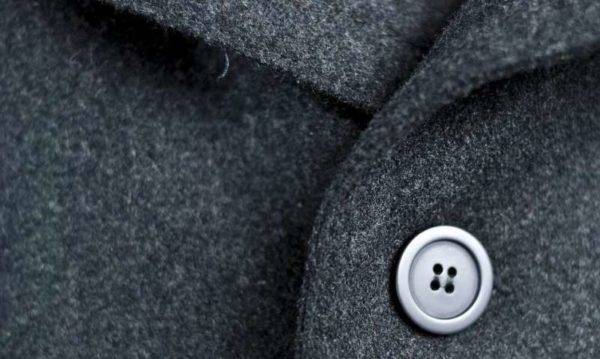
Dry cleaning guarantees the result in a few days
Table: Coats processing method depending on the fabric
| Dry cleaning | Wet cleaning | Washing | |
| Cashmere | Possible | Possible | Some types of cashmere (for example, eco-cashmere) are both hand and machine washable |
| Drape | Preferred | For stain removal only | Forbidden |
| Tweed | Recommended | For stain removal only | Manual is allowed |
| Wool | The most optimal option | Possible | Both machine (in the appropriate mode) and hand are allowed in a liquid detergent suitable for this type of textile |
| Leather | Ineffective | Recommended | Forbidden, only possible for lining |
| Suede leather | Recommended cleaning option | An effective way if used according to the rules | Forbidden for artificial, acceptable for natural fabric |
| Polyester | To remove dust | To remove stains | "Non-capricious fabric" allows you to use a delicate wash (but the result is difficult to predict) |
| Neoprene | Ineffective ways | Can be used in a typewriter, but twice to clean on both sides |
How to clean at home?
Greasy streaks and stains appear on the collar, pockets and sleeves. From clothes made of any material, they can be wiped off with talcum powder or starch. The powder is left in place for an hour, and then the cloth is brushed off.
The collar of a light drape or cashmere coat will be put in order:
- 3% hydrogen peroxide solution;
- a mixture of 4 tbsp. l. salt or soda with 1 tbsp. l. ammonia;
- ammonia and soap solution. First, wipe the surface of the product with a sponge soaked in a solution of soap, then blot the desired area with a cotton swab / sponge with ammonia.
To remove oily sheen from dark woolen coat details, the following are suitable:
- gasoline (process the product from the wrong side, placing a napkin or paper towel from the front on the spot);
- concentrated aqueous solution of baby or laundry soap;
- an aqueous solution of ammonia, prepared in a ratio of 1: 3;
- ammonia and glycerin (or denatured alcohol), taken in equal proportions;
- denatured alcohol diluted with water 1: 2;
- strong tea infusion.
Substances (except gasoline) are applied with a cloth to a pre-moistened surface, rubbed in, and after 15-20 minutes they are thoroughly washed off so that no streaks remain.
A tanned collar made of light suede will cleanse the soda dissolved in milk in a few minutes (a teaspoon for half a glass). But do not forget to carry out a preliminary test on an inconspicuous area of the product. Dark will renew the crumb of fresh bread, which is rubbed into greasy areas.
Salted spots on leather clothes are first treated with ammonia, and then with lemon juice. Not forgetting to treat the problem area with a solution of glycerin afterwards.
Polyester coat
Polyester is a synthetic material that keeps its shape perfectly, does not wrinkle, dries quickly after washing. Washing can be done by hand or in a typewriter. When choosing a particular wash, you need to adhere to some rules.
Handwash
Before washing the coat, brush off wool, hair, dust with a brush. Then turn to the wrong side. Place it in water that is about 36 degrees. In hot water, the coat may shrink. When washing a dark coat, use a liquid powder.In the case of a light-colored product, you can also take granular laundry detergent. If you are going to use bleach, choose a chlorine-free product. In case of heavy dirt, the coat can be soaked and left in water for 40 minutes. When washing the coat, you can use a clothes brush. It is not necessary to press strongly and rub, so as not to damage the material. Rinse the coat several times in cool water, adding a little conditioner. Squeeze the coat gently and gently so as not to deform the material. Place the coat on a hanger so that the water can escape. Then transfer the product to a warm room and lay it out on a large towel to dry it.
Machine wash
Front how to wash coat, you need to find out if it is machine washable. Look at the badges on the label. If the machine or basin icon is not crossed out, you can wash it. To begin with, the thing needs to be fastened, turned inside out and placed in a bag intended for washing. Wash your polyester coat in a delicate setting, or in a synthetic setting, add softener to soften the coat. Add detergent to the powder compartment only, not to the drum. Set the temperature regime to no more than 30 degrees. It is advisable to use a function such as an extra rinse. Disable the spin mode, because when twisting, the fabric deforms. At the end of the wash, remove the coat from the bag and dry the garment by placing a terry towel on a flat surface, and then spread the coat on top of it, straightening the fabric. While still damp, iron the coat through cheesecloth.
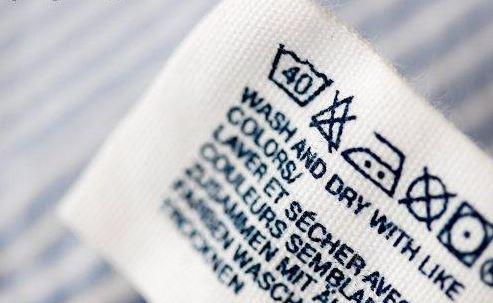
Examine the badge label to see if the machine is washable
Video: ironing a coat at home
If you adhere to the rules and follow the recommendations for the care of the coat, your product will remain in its original form for a long time. When purchasing a coat, do not forget to buy a cleaning brush, a roller with adhesive tape. If stains appear, take action immediately. Avoid heavy contamination, because then it is harder to get rid of them. Thanks to your efforts and care, your favorite coat will delight you for a long time!
Features of cleaning a woolen coat
It is recommended to dry woolen coat at home. However, some models can be washed. Read the label carefully before cleaning.
He will tell you how to properly care for a woolen coat, whether this material can be washed and dried. If the garment cannot be washed, use dry methods to remove dirt and stains, or have the garment dry cleaned.
For regular cleaning and maintenance of outerwear, use a special soft wool brush and a sticky roller or roller. Before cleaning, hang the coat on a hanger and roll it over the surface with a garment roller. It will rid the material of spools, clean it from dust, hair, wool and threads.
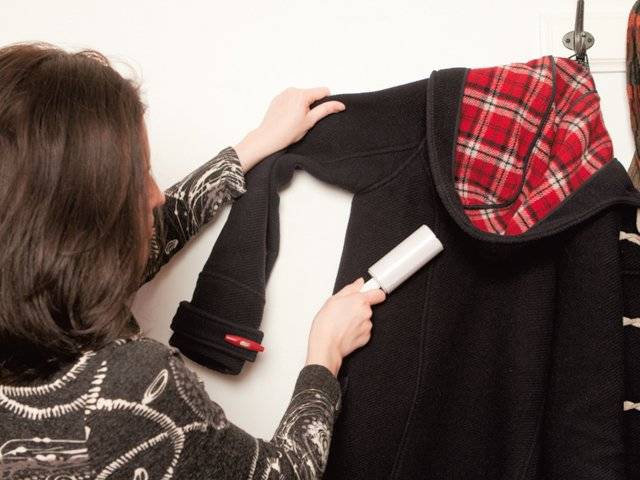
Examine the coat for stains and dirt, and don't forget the lining! Pay special attention to problem areas such as collar, pockets, cuffs and sleeve edges. Such areas are polluted and salted more than others.
Light dirt can be removed with a soft bristle brush. Brush in the direction of the pile.
If necessary, the brush can be slightly moistened with clean water or soapy water. But don't get the coat too wet! Wipe dirt on the material with a soft sponge, napkin, cloth or cotton pad. Never use hard sponges and brushes!
First, it is imperative to clean with a brush and a roller, and only then they start removing difficult stains. The spots are cleaned from the edges to the center, then there will be no streaks on the product. Stubborn dirt can be held under the steam jet before cleaning.
After dry cleaning, leave the wool coat to dry on a hanger in an upright position in the open air or in a well-ventilated area. You need to store the product in a special case for clothes. in the closet with doors.

Then the clothes will last a long time, retain their shape, color and presentable appearance. Now let's take a closer look at how to clean a woolen coat at home.
Polyester coat
You can restore the cleanliness of an autumn or winter coat from this material using a washing machine, but if you need to remove a small old stain, it is recommended to try the following methods:
- Stain remover. It must be applied to the stain and wait for the time indicated in the instructions. Then wipe the dirty area with a clean damp cloth or machine wash, if possible.
- Soap solution. Street dust and small dirt are removed with a liquid soap solution. You need to dampen a clean cloth in the solution and wipe the entire surface of the coat. The solution is prepared in the same way as for the drape.
- Stubborn stains on the coat can be treated with a 10% borax solution. They need to rub the stain and then rinse off.
Rice. 5 - Polyester coat
When drying, it is necessary to ensure that the sun's rays do not fall on the product, otherwise there will be burnt spots that will not be removed. Where to turn in such a coat or, for example, a down jacket from "Mango"? Dry cleaning or workshop.
Cashmere
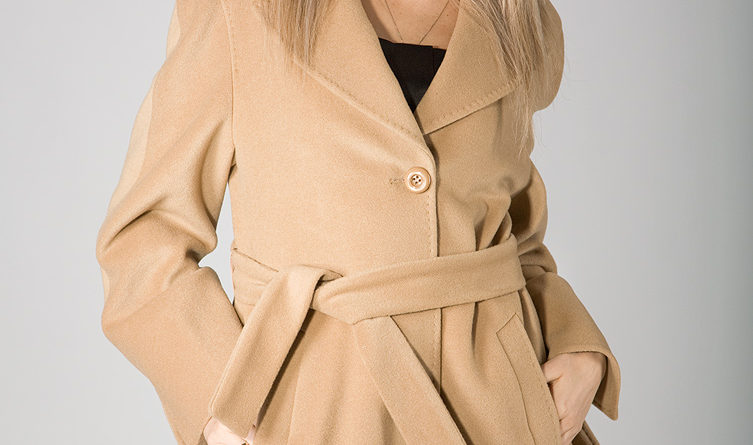
Rice. 2 - Cashmere coat
A product made from such material has its pros and cons. If only the collars, sleeves and cuffs of a cashmere coat with a down lining are soiled after wearing for several days, and the product itself looks clean, you need to proceed as follows:
- Warm water is poured into a large container.
- Shampoo or liquid soap is added to the water.
- The product is soaked in a container for an hour.
- Greasy areas are gently cleaned with a brush.
- The water is changed to clean water with the addition of an air conditioner.
- The last time the product is rinsed in clean water without cleaning additives and protective conditioners.
Tip: you need to dry cashmere in a special gentle way, otherwise it will shrink. Since the coat can easily lose its shape, drying in the automatic machine is prohibited. After the last rinse, the item must be laid out on a large terry towel.
Then the towel, along with the outerwear, is carefully rolled into a roll. Thanks to this, a gentle push-up occurs.
Then a dry towel is spread on the table, and the coat is laid out on it, straightening all the folds
Particular attention should be paid to the adhesives and backing. Since cashmere cannot be ironed in most cases, these places must be carefully leveled to avoid creases.
After all procedures, the product is left to dry naturally.
To remove stains from cashmere without damaging the color, you can do this:
- It is good to remove stains on a light-colored coat with ammonia. It is necessary to moisten a cotton pad in an ammonia solution and rub the dirt. For greasy stains, use talcum powder or starch.
- If sprinkled with dirt, you can clean the black or dark brown coat with coffee infusion. They moisten a cotton pad or clean cloth with it and wipe the dirty area.
- Black bread crumb is a folk remedy that allows you to clean a thing from dust so as not to damage its color. To do this, lay out the product on the floor, cover with crushed crumb and roll it over the entire surface of the coat until it turns into balls.

Rice. 3 - Cashmere cleaners
Dry cleaning the wool coat
Garment manufacturers indicate how to clean wool coats. All information is on the label. If an empty circle is drawn on it, then the product can be dry-cleaned or dry-cleaned. Primitive dry cleaning of wool garments is done with a washing powder, soft brush, steamer or iron. It is recommended to perform it if the coat is made from 100% wool, which is why it is poorly cleaned with bleaches and folk methods.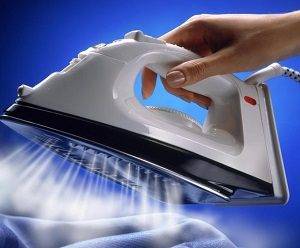
Execution algorithm:
- Remove fluff and fluff from the coat with a soft brush and roller.
- Lay out the product on a horizontal surface.
- Pour laundry detergent onto the coat. It is not necessary to rub the substance roughly; it is enough to lightly walk over the powder with a soft brush so that it gets between the villi.
- After half an hour, remove the powder with a brush.
- Hang the coat on a mannequin or hanger, straighten it and walk over the entire surface with a steamer. Iron the product in the area of the hanger.
- Dry in a well-ventilated area, avoiding direct ultraviolet radiation.
We clean the drape coat - instructions
Drap is a popular material for the production of men's and women's coats. To clean it, the same products are suitable as for cleaning carpets and carpets. You need to act according to the following instructions:
- dilute the product in water and lather;
- Apply foam to the stain and while it dries, clean the stains with a soft bristled brush.
If we are talking about a coat of light shade, you can use dry "Vanish" - just sprinkle it on the thing and after a while remove the rest of the powder with a brush. You can wash your clothes if the label says it is okay. But what if the product cannot be washed, and carpet foam did not help to cope with stains?
Try a soapy solution. You can use it to clean stains as follows:
- mix the detergent for wool with water until a weak solution is obtained;
- soak a clean cloth in the mixture and treat the dirty places on the clothes with it (the cloth should get a little wet, and you don't need to rub the dirt too much);
- wait about 20 minutes - during this time, the agent will begin to act;
- remove the soapy water by dampening the coat and blot the remaining moisture with a dry towel;
- hang the product on a hanger to dry.
Can the woolen coat be washed
Coats made from 100% virgin wool cannot be washed. The rest of the products can be washed if the tag permits it. More details on the values on the label of clothes and things can be found here
However, the coat should be washed very carefully and only on a delicate cycle using special detergents for wool.
For washing, choose a special shampoo, conditioner, or liquid detergent for woollens. When rinsing, use fabric softeners to soften water and material.
In a washing machine, coats are washed at a delicate mode with a temperature of up to 30 degrees without spinning! The product must be placed in a bag or a garment cover, or washed, wrapped in a duvet cover or pillowcase.
You can also wash your woolen coat by hand. To do this, use a large volume of cold water and detergents for woolen clothes. After washing, rinse the garment thoroughly at least two to three times to avoid soap marks and streaks. Wringing out the coat is not recommended.
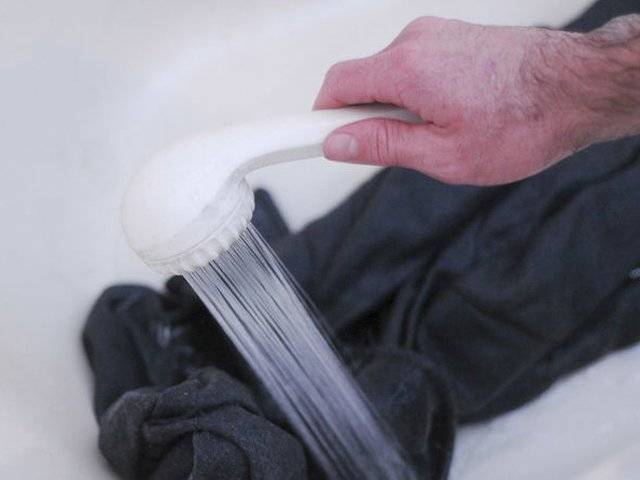
The woolen coat must not be twisted or rubbed strongly, dried vertically, dried in dryers and a washing machine, with a hair dryer or heating appliances, in direct sunlight! Do not wash the garment too often, otherwise it will stretch and lose its shape. Do not wash your woolen coat if the tag prohibits it.
It is important to properly dry the product so that it does not stretch or lose its shape. To do this, after washing, wrap the coat in a large terry towel or a light-colored terry sheet and leave until the fabric absorbs excess moisture.
Then lay the garment on a horizontal surface, carefully flatten the material, remove wrinkles and unevenness. Dry the woolen coat in the fresh air without direct exposure to sunlight or in a cool room with good air circulation away from the battery.
Hand and machine wash
Can the coat be washed? An unambiguous answer cannot be given. It all depends on the material that was used for sewing. So, polyester and cotton-based fabrics (raincoat fabric, moleskin, diagonal) tolerate washing well on hands and in a typewriter. Ratin, tweed and woolen velor should not be washed.In other cases, follow the manufacturer's recommendations on the label.
If a decision is made to wash, then you need to prepare the thing, as well as for dry cleaning. In addition, you need to unfasten the fur collar from the winter coat, remove the belt, fasten the zippers and buttons. Let's consider in more detail the features of washing products from different fabrics.
Polyester
The material belongs to the category of the most unpretentious to care for. The polyester coat can be washed either by hand or in the washing machine. In order not to damage the product, the following rules must be observed:
- Immerse the coat in water no higher than 40 °. Otherwise, it will deform, and folds will appear on it, which will be impossible to smooth out.
- When washing by hand, soak the item in water for no more than a quarter of an hour.
- Do not rub or squeeze the fabric too much.
- If you are going to wash your coat in the washing machine, you should select the "synthetic" or "delicate" mode. Place the garment in a laundry bag or pillowcase before placing it in the drum.
- A clean product is carefully straightened, smoothing its surface with your hands.
From wool
The general rule for washing wool models is that the water temperature is not higher than 30 °, the manual mode and no spinning. In detail, the process differs for different materials.
- A woolen coat can only be washed by hand, using a liquid (best of all special) detergent. This should be done quickly so that the fabric does not have time to absorb too much water.
- A cashmere garment tolerates any wash well, only if it is allowed by the manufacturer. The main thing is not to expose delicate fabric to intense mechanical stress. It cannot be wrung out and rubbed hard. Only liquid detergents are used. At home, cleaning a cashmere coat is best done dry (described in the dry cleaning section).
Suede
It is not recommended to completely wet models made of natural suede; it is better to remove dirt locally. If there is a strong need, then use a sponge dipped in soapy water. You cannot rub and squeeze the suede even slightly. A special brush will help to lift the villi. After washing, the product is treated with an aqueous solution of glycerin so that the material does not become tough.
Leather
Only the lining of a leather coat can be washed. The product is turned inside out and cleaned with a sponge.
Outerwear, especially a woolen coat, takes a long time to dry. To speed up the process, you can turn on a fan next to the hanger. Drying near the heater and battery is excluded.
We remove the smell
Outerwear, especially wool coats, absorb a variety of odors, including sweat and cigarette smoke. Airing usually helps to get rid of them. But there are other effective ways as well.
Sweat
The smell of sweat from the coat eliminates:
- Universal spray for fabric with silver ions. The product is sprayed onto the armpit area and wait until it dries completely.
- Activated carbon. The problem areas of the coat laid out with a lining upwards are sprinkled with a powder of several tablets. After 2-3 days, the coal is removed.
- A solution of ammonia or vinegar. The product is diluted in water (2 tbsp. L. Per 200 ml) and, moistened with a sponge, treat the unpleasantly smelling areas. Then the coat is aired for 6-8 hours.
- Baking soda. It is poured onto the lining areas damp with sweat at night. In the morning, the crystals are brushed off.
- Lemon juice or citric acid. The liquid is rubbed on bad-smelling areas and allowed to dry. To enhance the effect, vinegar is added to the juice.
- Salt. Prepare an aqueous solution (1 tbsp. L. Per glass) and apply it abundantly to the fabric.
- Multi-component composition. To 4 st. l. water is mixed with 1 tbsp. l. salt and 3 tbsp. l. ammonia. The resulting mixture is used to treat the armpit area from the side of the lining.
The tobacco smell emanating from the coat removes:
- Steam treatment. It is suitable for wool and cotton items. The coat is ironed with a steam iron or with a regular iron through a damp cloth.The first option is better, since some materials, such as cashmere or vigoni, cannot be touched with an iron.
- Ground coffee. It is placed along with things made of drape, crepe, cashmere or other woolen fabric in a closed cover for several days. When the tobacco smell changes to coffee aroma, the coats are hung out in the open air for ventilation.
- Mint or oregano. The principle of application is the same as in the previous case. Dry leaves are placed in a linen bag and kept next to clothing until the problem is completely eliminated.
- Table vinegar. A coat, smelling of cigarette smoke, is hung on a hanger. An open container with vinegar mixed with hot water is placed next to it for several hours.

